This post contains affiliate links. We earn commissions if you purchase products from retailers after clicking on a link from our site. As an Amazon Associate, we earn from qualifying purchases.
I’m so glad you’re here! Listen, I’ve worked really hard to practice so many instruments for a month and I feel I have a better perspective than most to share with you which instruments are easiest to learn.
It turns out that easy isn’t easy to quantify! But I’m going to make it easy to understand how easy these instruments are.
(Many of these instruments are fairly cheap, too. You can see a list of cheap instruments, here)
I’ll explain the easiness using these 5 categories:
How easy is it to
- Start making a sound
- Figure out basic techniques
- Play a song
- Read Tabs
- Get to Intermediate Competency (Be at the point where you can play beginner and intermediate-difficulty songs)
Tin Whistle
The Tin Whistle is actually one of my favorite instruments to play. One major reason is that it’s easy to get the basic competency down, so it’s a super satisfying instrument to learn and play.
In fact, you can see how far I was able to get with the Tin Whistle after just 30 days of practice (an hour a day). Check it out, here:
By the way, looking for recording equipment and musical instruments? Check out Sweetwater.com for microphones, monitors, audio interface or any other recording gear that you could ever need. (Affiliate Link)
In my opinion, the tin whistle is a very approachable instrument, especially those new to music in general. What I also love about it is that the instrument has incredible depth, you can play amazing music if you want to pursue upper-intermediate or even expert level.
Good Beginner Tin Whistle To Get Started
I absolutely love my Clarke Sweetone tin whistle (got it on Amazon, here). It was so inexpensive that I thought it was a toy or a joke, but it truly is a beautiful instrument that you can play for hours.
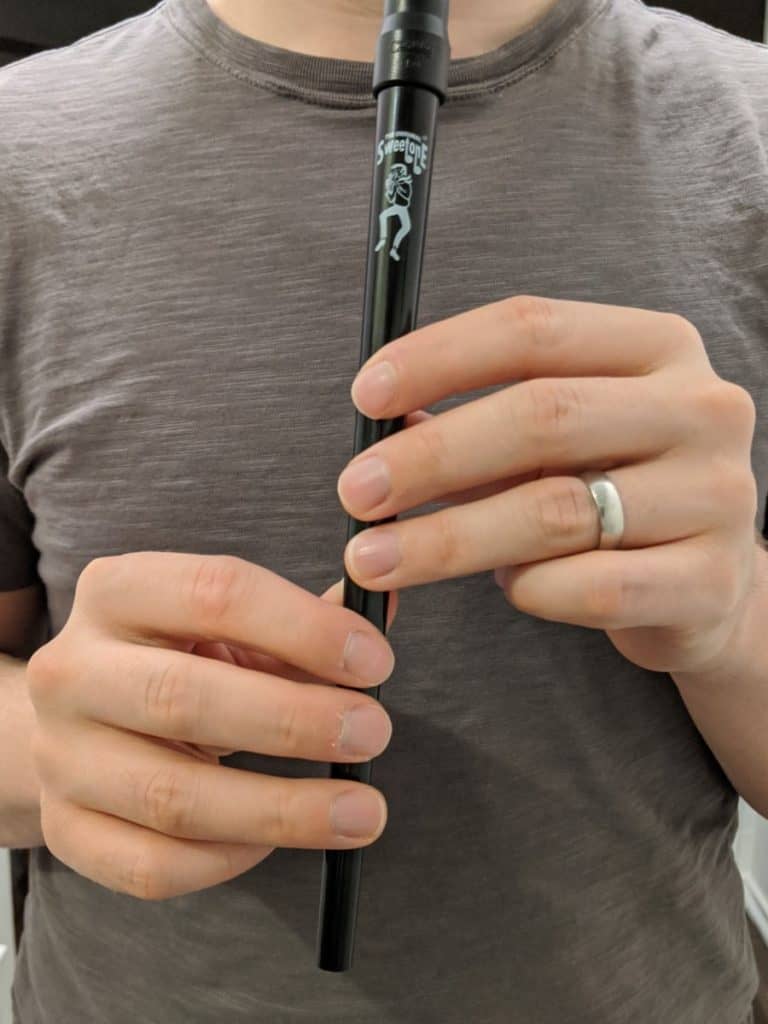
I would stick with a key of D for beginners, although the key of C is a good choice, also. D is most common for the music you will find online to play along with.
Reasons Why the Tin Whistle Is Easy
- Diatonic: You only have 7 notes to worry about. It’s harder to mess up
- Only 6 holes: The recorder has 10 holes, and concert flutes have 15-17 keys to worry about. (see our article about how many holes flutes have, here)
- Small and compact: Although bass tin whistles require stretching your fingers quite a bit, a standard tin whistle is comfortable to hold and play all the notes
- No buzzing or special embouchure to get started: Many instruments require specific techniques to even make a sound. For fipple flutes like the tin whistle, you just blow!
Easy Analysis
| Category | Why This Score? | Score (1/5) |
|---|---|---|
| Making Sound | Fipple flutes are extremely easy for anyone to make a sound, you just blow into it. So if you got lungs, you can make a sound on the tin whistle. | 5 |
| Basic Techniques | The basic techniques for the tin whistle are fairly simple. You only have to coordinate your fingers covering 6 holes, and you have to learn the breath control to go between two (maybe 3) octaves. The most difficult part for beginners is learning how to properly cover the holes and use the right amount of air. | 4 |
| Play a Song | Playing songs that only have 5-6 notes is very approachable. It’s easy to go between different notes that are close to each other, and within an hour you will be able to play Mary had a Little Lamb. | 5 |
| Read Tabs | The tabs for tin whistle are pretty easy to understand. You can see an example of tin whistle tabs here. | 4 |
| Intermediate Competency | At the end of 30 days (30 hours) I could play dozens of different songs and be able to play basic techniques as well as some intermediate techniques. Mastering the tin whistle is a completely different story, but being able to play the songs you like is in reach after not too much time with the tin whistle. | 4 |
Final Score (Higher Is Better)

Harmonica
The harmonica is an amazing instrument. It is dead simple to get started, but is actually a surprisingly rich instrument with lots of depth. Listening to a professional harmonica player is impressive and is also kinda intimidating, but don’t let you stop enjoying this beginner-friendly instrument!
I also practiced the harmonica for 30 days for an hour a day. You can see how far I got and how much you can learn in a short period of time:
Although the harmonica is very easy to get some of the basics down, getting past that can be a challenge. One thing I noticed for myself was how hard it was to figure out breath control, not to mention mouth endurance.
Yeah, you’ll not really hear people talk about this, but your mouth gets tired as you learn the intermediate techniques! Getting past that will require practice.
Good Beginner Harmonica To Get Started With
Finding the right harmonica can be tricky, actually, because if you go for too cheap you’ll get frustrated with how difficult it is to play, but if you go too expensive you may be in over your head with the instrument.
I was pretty satisfied with the Hohner Special 20 I bought as I was learning the harmonica. You can find it here on Amazon. I would stick with a key of C harmonica for beginners.
Reasons Why the Harmonica Is Easy
- The standard harmonica is diatonic (chromatic harmonicas are out there!): with only 7 notes to worry about, it’s easier to make music that sounds great
- Small and compact: The harmonica fits in your pocket, nicely (see this list for other small instruments if you’re interested), making this a more approachable instrument for kids or adults.
- Only lungs are required: To play you simply breathe in and out, making it one of the more intuitive instruments.
Easy Analysis
| Category | Why This Score? | Score (1/5) |
|---|---|---|
| Making Sound | The harmonica may be one of the easiest instruments out there to make a sound. What’s great is the sound of just blowing air into and sucking air out of the harmonica sounds good all by itself. Because of this, the harmonica is a good choice for kids who just need an introduction to musical instruments without the punishment of having to learn a bunch of technique before getting started. | 5 |
| Basic Techniques | The absolute basic techniques are fairly simple to learn, you put the instrument to your lips and then you blow. However, learning to blow into only a single hole proves to be challenging for some. | 4 |
| Play a Song | Once you can play one hole at a time, it becomes pretty simple to play very basic melodies. | 4 |
| Read Tabs | Not gonna lie, although you can get used to it, harmonica tabs are a bit weird. They use numbers to say which hole to blow into, and then add a “-” symbol to the number, which means to suck air rather than blow air into the harmonica. For example: 1 -2 -5 4 would mean blowing air into hole 1, sucking air from holes 2 and 5, and blowing air into hole 4. It makes sense, but actually trying to follow a tab can be an exercise in patience. | 3 |
| Intermediate Competency | You can learn the basics quickly for the harmonica, but learning some of the more intermediate techniques such as pitch bending, intermediate rhythms, and even how to use your hands to shape the sound can be pretty darn tricky to put together. | 2 |
Final Score (Higher Is Better)

Bongos
The bongos are a brilliant instrument design because they’re portable but still have a great sound. The bongos are very approachable and a fantastic entry to music rhythm.
You can use the bongos in a big ensemble or they can be the entire percussion session for a guitar and a vocalist. You can just jam with your friends or play along to the music you love. They’re just great and I love them.
The best part about bongos is that they’re easy to get started. How easy? Well, I submit Exhibit A:
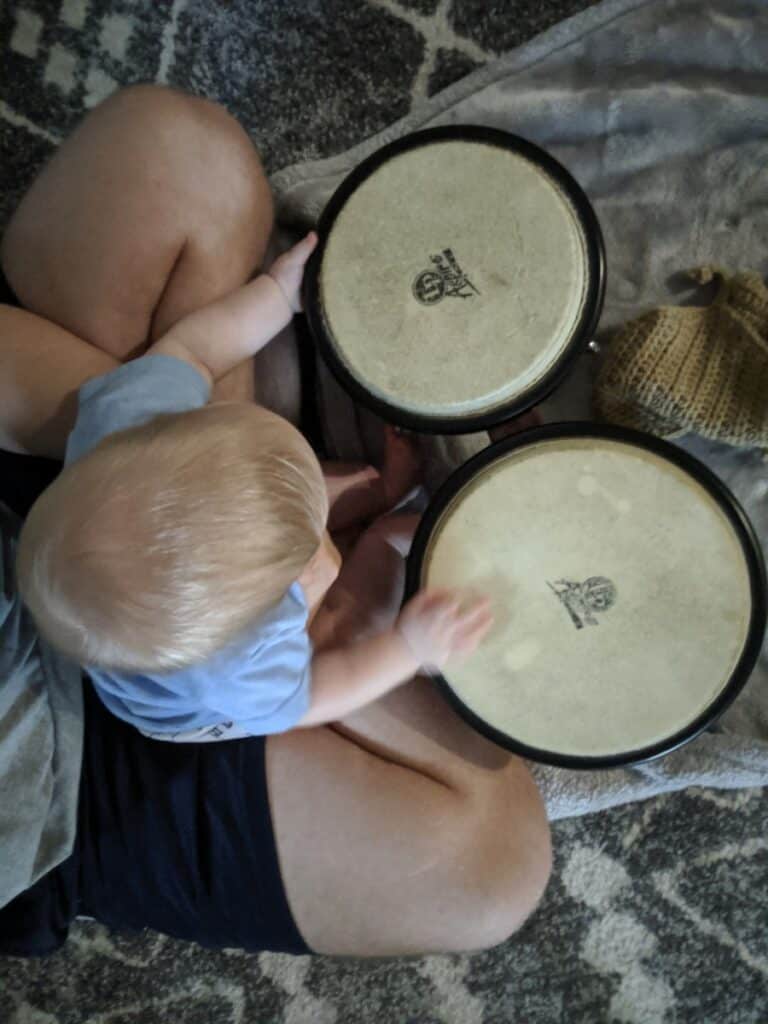
My son could “play” the bongos when he was only 6 months old. He also would try to eat them, but still, the fact that someone so young can enjoy the sound and experience rhythm shows me how accessible the bongos really are.
Even though I’ve had these bongos for a long time, I recently spent 30 days (30 hours) of practicing the bongos to see what I could learn. And it turns out quite a lot! Even though the bongos are simple, they are a deep instrument where you can actually make a variety of different sounds, and some percussionists spend their lives playing the bongos! You can see what you can learn in 30 days of playing, here:
Good Beginner Bongos To Get Started
I got my first set of LP Aspire bongos about 18 years ago when I was a teenager. They’re still in great condition, and although a true bongocero (bongo player) would be offended to know this: I haven’t changed the drum heads in all that time.
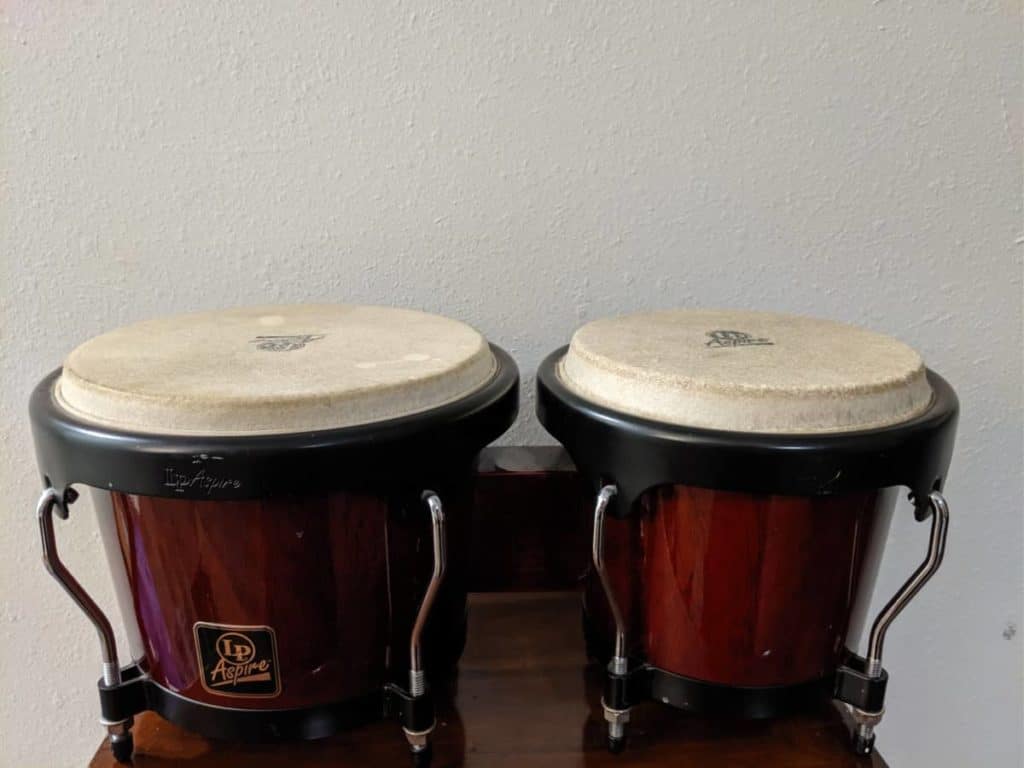
The LP Aspire bongos aren’t the cheapest bongos you can find, and they are certainly entry-level, but they’re of a very decent quality that will work for a beginner to an intermediate player for years.
You can find LP Aspire Bongos here at Sweetwater.
Reasons Why Bongos Are Easy
- Compact: You don’t have to set up a drum kit or dedicate a space in your garage or den to the instrument (like you would regular drums)
- Easy to make a sound: Bongos are intuitive to play (even for a small child), you just hit the drum and enjoy the sound
- Only two drums simplify coordination: Many other percussion kits involve many more drums, and having just two makes it simpler and easier.
Easy Analysis
| Category | Why This Score? | Score (1/5) |
|---|---|---|
| Making Sound | Bongos absolutely rock in this arena. You simply hit the drums to make the sound. Now, don’t get me wrong, there is so much finesse to learn when it comes to playing the bongos, but for an absolute beginner, you can be making a rhythm in less than 60 seconds. | 5 |
| Basic Techniques | So, the bongos are actually a surprisingly rich instrument. The number of techniques that change the sound of the bongos is almost unlimited–there are so many different things you can do. But the basic slaps are simple. Coordinating them can be difficult, but actually producing the basic sounds of the bongo drums is not hard to get started. If you want to learn the basic techniques as well as how to take care of your bongos, check out my video, here. | 5 |
| Play a Song | This is where the bongos can be tricky. In order to play along with music you need to learn how to keep time–and that can be very easy for some people and can be difficult for others. I’m convinced though that most people can do it if you start simple and keep your expectations realistic. If you can count along to a rocket launch, I know you can play the bongos. Start with basic rhythms, even if they are just hitting the bongos on the beat. Find a metronome app online and just tap the bongos on every click to get started. | 3 |
| Read Tabs | Bongos have a simplified sheet music rhythm tab (see here if you want to learn how to read bongo sheet music). Understanding which drum is which is simple, but learning how to understand time signatures and rhythm, in general, is a bit difficult. | 3 |
| Intermediate Competency | After practicing bongos for 30 hours, I was amazed at how much I didn’t know, still. Learning to play the basic techniques for the bongos is easy, but learning intermediate and expert rhythms is really hard. The coordination needed for fast songs and rolls and other syncopated rhythms can take months of solid practice to solidify. You can probably learn all the skills in a year of solid practice, but to be able to be rock-solid in your playing takes a lot longer with plenty of experience playing in groups. | 3 |
Final Score (Higher Is Better)

Kalimba
The kalimba (also known as a thumb piano) is a beautiful instrument. The sound is relaxing and can even be haunting. Paired with the sound of rivers and waterfalls and you’ve got the perfect lullaby.
The kalimba is not only easy to carry around, but it’s also easy to learn the basic techniques for how to play. In fact, I made a video about how to play the basics of the Kalimba that you can find, here.
The kalimba is an approachable instrument, it’s easy to play the notes and if you get a kalimba with the note names engraved on the tines (the metal rods that make the sound), it makes it simpler if you’re just learning music.
Good Beginner Kalimba To Get Started
I love my Kalimba and I think it’s a great option for those wanting to get into the instrument. It’s inexpensive and beautiful to look at as well as beautiful to listen to.
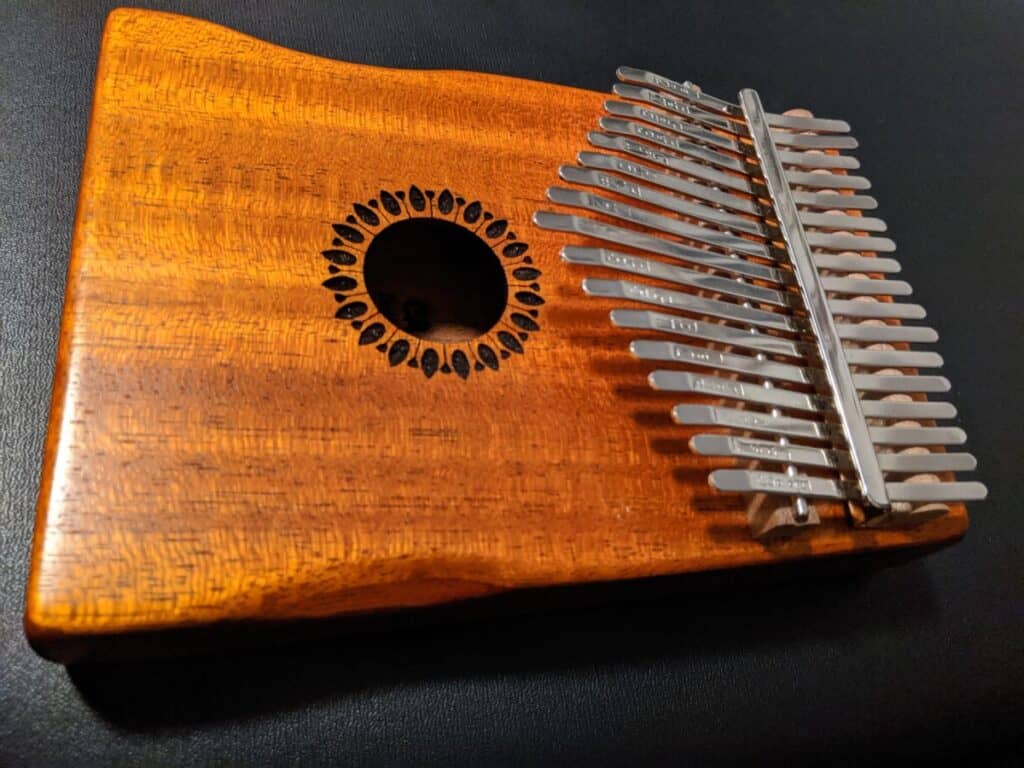
I got mine on Amazon, here. (for Christmas, one year)
Reasons Why the Kalimba Is Easy
- Small and compact: Easy to carry, easy to play. If you have issues with your thumbs you can put the kalimba on a flat surface and play with your other fingers.
- Diatonic: There are many types of kalimbas out there, but most of the less expensive kalimbas are diatonic, which makes them easier to play and make beautiful music.
- Intuitive note arrangement: The notes are laid out in front of you, with the notes ascending and alternating in both directions. So not exactly like a piano, but it’s easy to figure out the concept.
- Visual notes: Seeing where your notes are makes it easier to play the notes you want. For instruments that you use your lungs to play, you have to pick the notes out of the air, so to speak.
Easy Analysis
| Category | Why This Score? | Score (1/5) |
|---|---|---|
| Making Sound | Plucking a tine (the bits of metal that resonate on a kalimba) is like pushing a button, you simply press down on the tine. There is a bit of technique to it, though–you have to press the tine in such a way as to not bend the metal. It’s trivial, though, and will only take a few minutes of fiddling to get it right. | 4 |
| Basic Techniques | Learning to pluck the tines is pretty simple, but there are some tricks to the kalimba that actually some practice to figure out. Being able to play one note at a time takes some coordination and practice. | 4 |
| Play a Song | Being able to play with both thumbs alternating back and forth takes a bit of work but you should be able to play a simple song within an hour or two. | 4 |
| Read Tabs | I would say that proper kalimba tabs are some of the most difficult to read tabs I’ve ever seen. You can see some of these types of tabs in my video I link to above. However, you can use simplified tabs, which require understanding which notes are which, but I would argue they are easier to understand. You can see an example, here. These tabs can still get pretty tricky, actually. | 2 |
| Intermediate Competency | I actually struggled to progress in this instrument past the basic song making. For me it was difficult to coordinate both thumbs in such a way to be able to play quickly, and accurately, and to jump between low and high notes. All of these skills are intermediate skills and with 30 hours of practice I wasn’t there. | 2 |
Final Score (Higher Is Better)

Piano
The piano is a world-class instrument. Depending on what you listen to, it may be one of the most common instruments approaching the guitar.
Now, hear me out, you might be thinking “the piano is not easy”. And that’s true. The bar is set really high for piano playing such that it can be intimidating.
However, in my opinion, the piano is one of the easiest instruments out there if you want to play basic songs or play chords. (groups of notes).
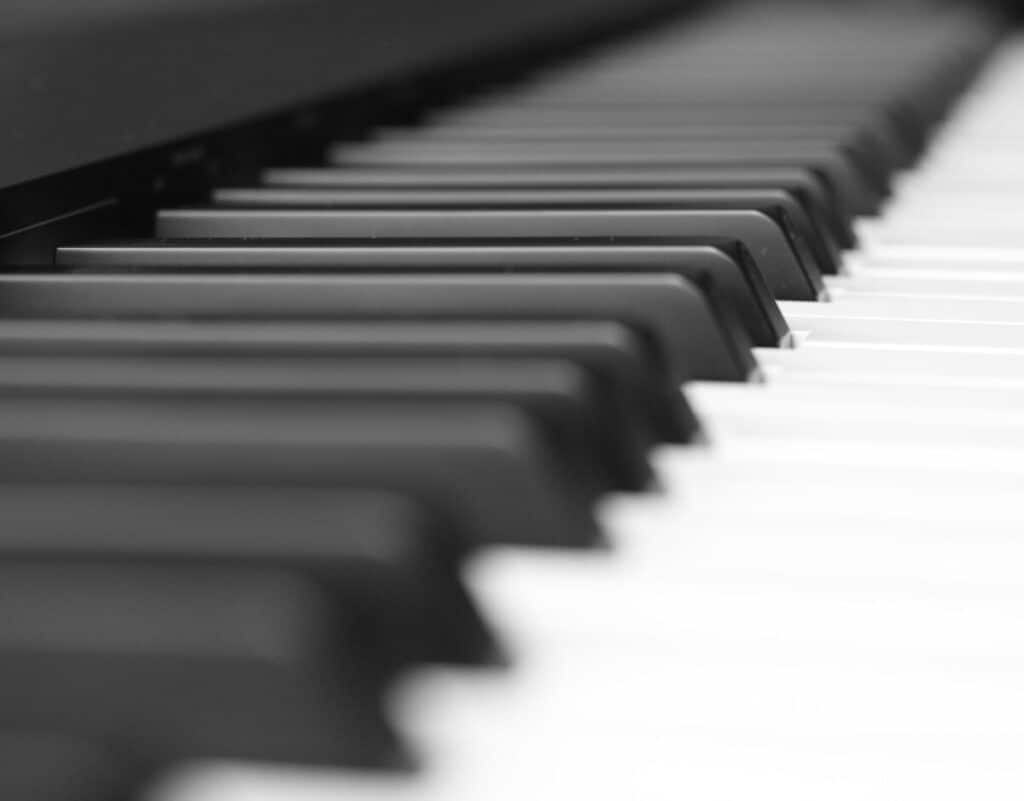
The reason why you might think the piano is hard is that you’re comparing yourself to experts or intermediate players. As far as basic competencies the piano is one of the best ways to learn an instrument and learn music theory.
So, no, it’s not easy to learn to play at an intermediate level on the piano, especially if you are playing note for note–however, there is more than one way to learn the piano.
How To Learn A Piano the Easy Way
I actually took a course from Pianoforall, and I really enjoyed the course–the reason I loved it is that it approaches learning piano from a totally different perspective than what I had with piano lessons. And for sure, I wish I started with Pianoforall rather than traditional piano lessons.
You can find my full review of Pianoforall, here, (has a before and after with 30 days of practice), or you can learn more about the course here.
So overall, yes, getting serious with the piano is not exactly easy, but it is one of the best instruments to learn music out there.
Easy Analysis
| Category | Why This Score? | Score (1/5) |
|---|---|---|
| Making Sound | The piano is one of the easiest instruments to make a sound. You simply depress the keys and you make a sound. | 5 |
| Basic Techniques | The piano has a very strong advantage in that you can see the notes. In instruments where you use your breath, you can hear the notes but there is no visual representation. In fact, the piano is so incredible as a visual representation of notes that many times while learning other instruments the piano is used as a reference! So while seeing the piano makes it much easier to know where the notes are, the most difficult part about learning to play piano is learning to coordinate both hands to play together. This takes a decent amount of practice. However, if you are playing with chords or sticking with very simple melodic songs, you can learn a lot more than you think fairly quickly. | 3 |
| Play a Song | If you set realistic expectations, you can learn to play very simple songs with one hand only within a couple of hours. If you’re learning to play with chords, you can learn to play simple songs that actually sound great very quickly. | 4 |
| Read Tabs | Okay, to be honest, this is the hardest part about the piano. Piano does have its own tablature, but the most common way to learn Piano is via sheet music. Learning how to read sheet music is tough if you haven’t learned it before. It’s got a lot of rules and parts to it that require study and practice. The good news is that if you learn how to read sheet music, you now have a superpower that will help you learn whatever instrument you want in the future | 1 |
| Intermediate Competency | Learning to play the piano at an intermediate level means learning chords and learning how to read sheet music. This can take a year of solid practice to get to. | 1 |
Final Score (Higher Is Better)

Melodica
The melodica is an instrument popular for teaching beginners in music, but it actually shows up in actual professional songs as well.
The melodica works similar to an accordion or a harmonica (they are all free-reed instruments). To “power” the melodica, you simply blow into the end of the instrument or you blow into a hose that’s connected to the melodica.
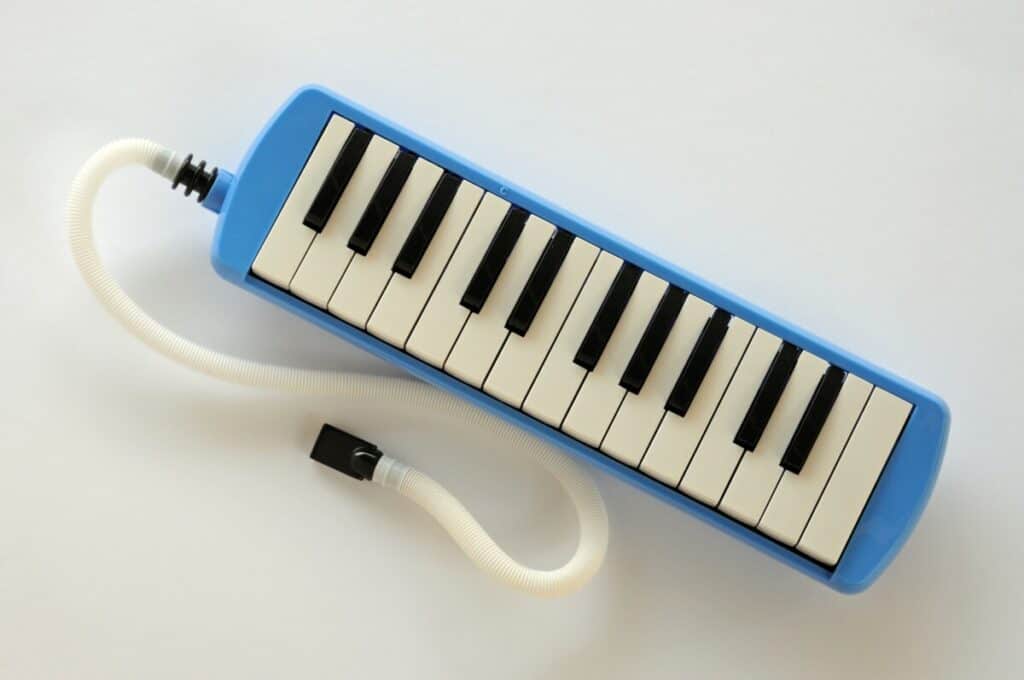
Reasons Why the Melodica is Easy
- Limited keys: Melodicas vary in the number of keys but there still is a limited amount of keys compared to the piano, simplifying the instrument.
- Small and Portable: Can fit in a backpack–no complicated setup needed
- Designed to be played with one hand: The melodica is well-suited to play melodies and simple chords. Since the melodica can be blown directly into, the melodica is designed to be held with one hand while the other plays the melodica.
Easy Analysis
| Category | Why This Score? | Score (1/5) |
|---|---|---|
| Making Sound | The melodica is fairly simple to make a sound but you do have to learn to coordinate your breathing with your playing. You simply blow and push the buttons at the same time. | 4 |
| Basic Techniques | The melodica is very much like a small piano, but with much fewer keys which means you only have to learn to play 2-3 octaves. | 4 |
| Play a Song | The melodica is great for learning to play simple melodies. With just a little practice you’ll be able to play a simple song within an hour. | 4 |
| Read Tabs | Melodica tabs are sheet music, so the difficulty and complexity of sheet music is true for the melodica, too. Regular sheet music is hard: 1 There are melodica tabs that show highlighted keys to play–those are a good starting point if you are just starting out with music and don’t want to commit to reading sheet music. These tabs are easier: 3 | 1 or 3 |
| Intermediate Competency | Getting good at the melodica is much simpler of an affair than getting “good” at the piano. There is just so much less of a dynamic range.. However, the road to intermediate competency still means learning sheet music and learning chords and other music theory as well learning the ability to play quickly all while controlling your breath. | 3 |
Final Score (Higher Is Better)

Auxiliary Percussion
Auxiliary percussion covers hundreds of different percussion instruments. I could talk about them one by one, but this article would go on forever since there are so many.
If you’re in a band or an orchestra, if you are in the “percussion” section, you will probably use all of these at some point.
I’ll list out a few examples here:
- Shaker: Many shakers are small, fitting in the palm of your hand. This may seem like a tiny insignificant instrument, but shakers can make an incredible difference in the feel of a song. Shakers can be like a cylinder or like an egg, or various other shapes
- Maracas: Similar to a shaker in principle, a maraca is simply a shaker with a handle, but they come in many different sizes and have many different sizes of beads that you shake around, all of which have different sounds. Maracas are often played in pairs, with both held in the same hand.
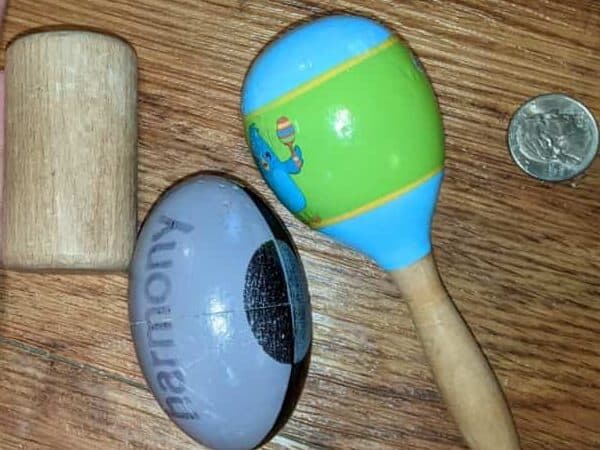
- Tambourine: The tambourine is a frame with tiny cymbals attached that clap together when shaken. Some tambourines have heads and others do not.
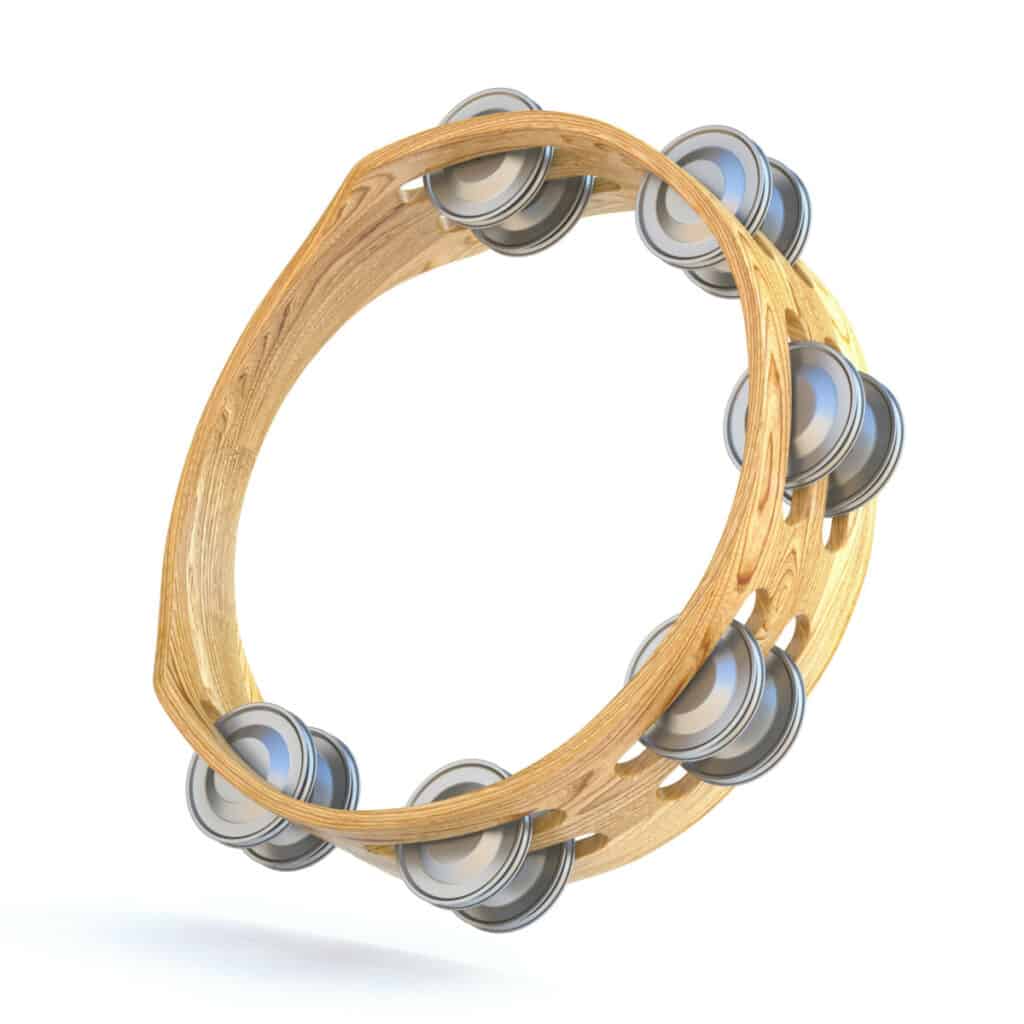
- Triangle: This is a very simple instrument where you simply use a striker to ring the triangle (like a bell). Simplicity itself.
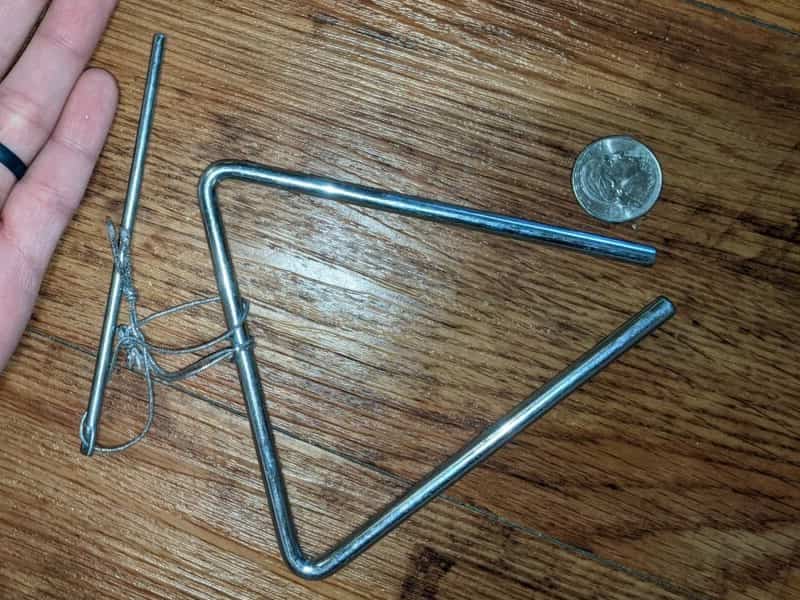
- Guiro: The guiro is an instrument where you use a striker to rub against the ribs of the instrument or tap it to make a hollow clicking sound. A simple instrument, but many songs wouldn’t be the same without them.
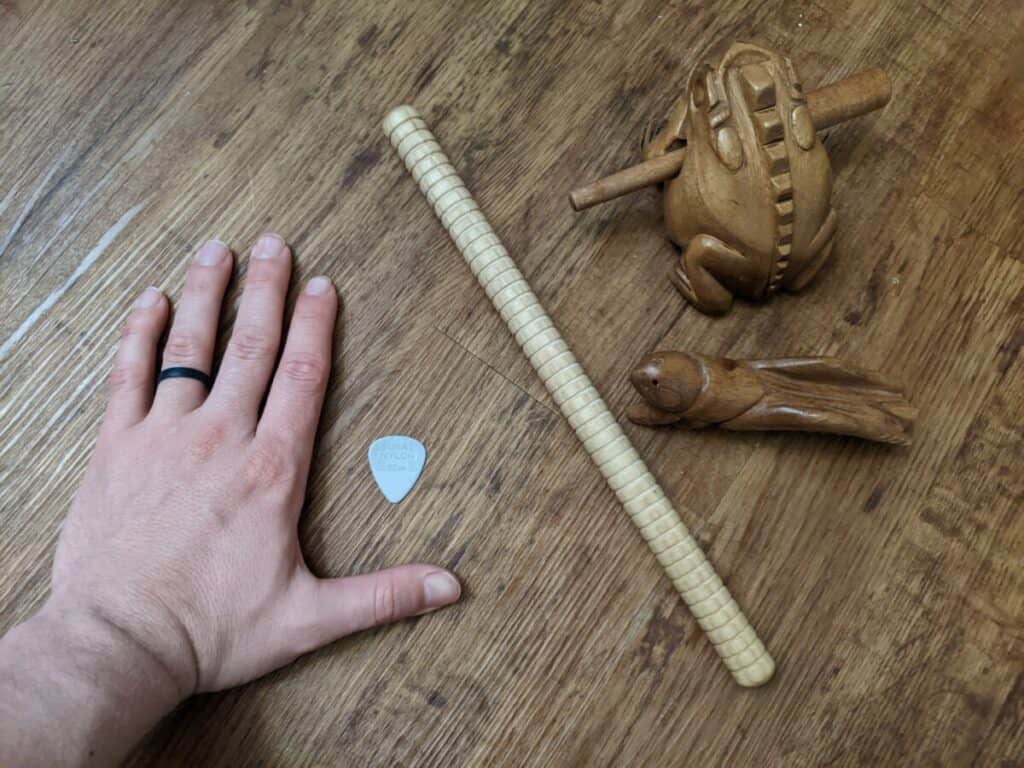
- Sleigh Bells: Sleigh bells are the sound of… well… sleigh bells. There are many different types, with some being designed to be attached to a limb.
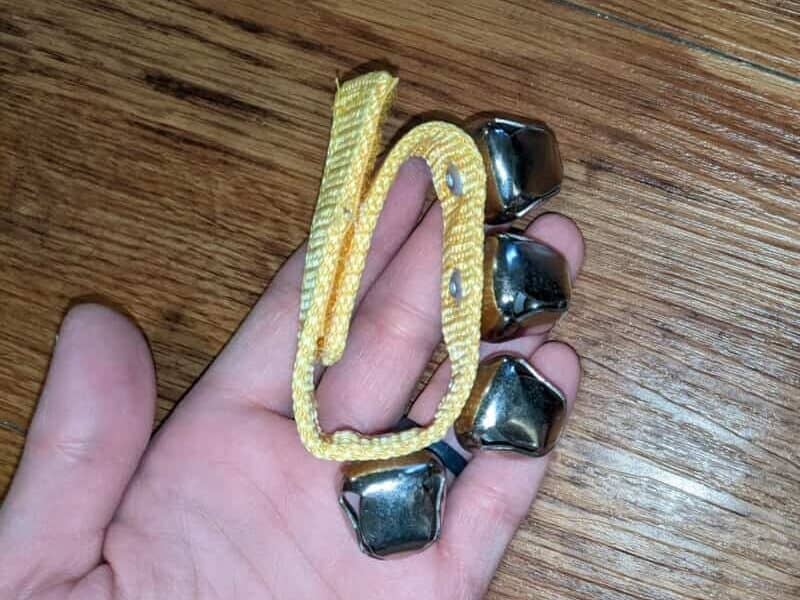
- Agogo: An agogo is simply two cowbell-sounding bells that are attached in some way so you can alternate between the two with a drumstick
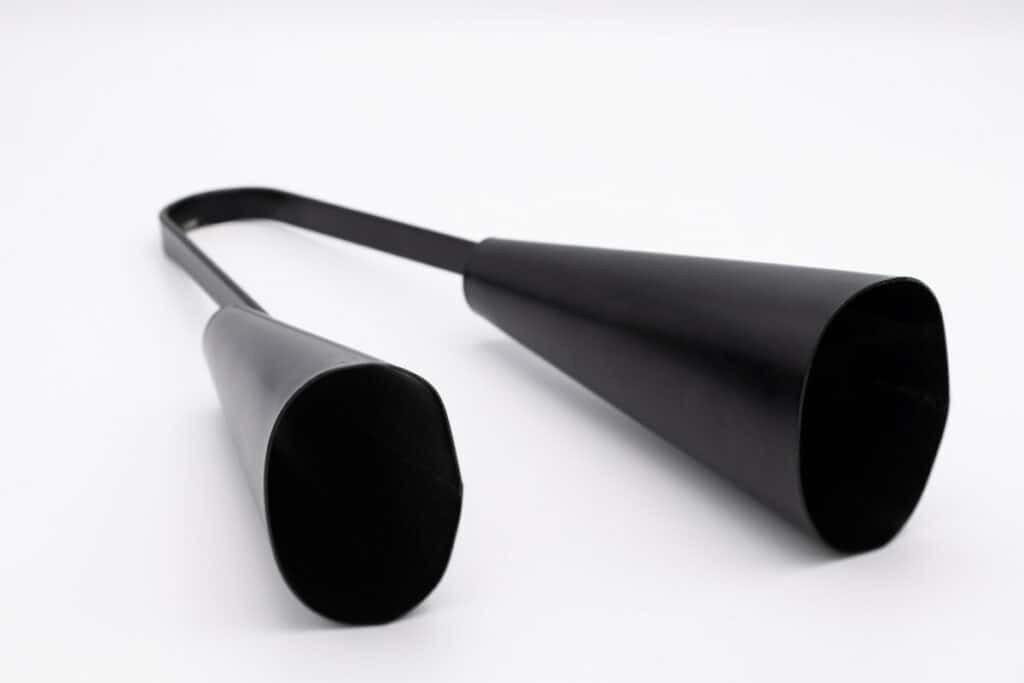
This list doesn’t even begin to cover the number of auxiliary percussion instruments.
One thing that’s true about all of these is that they are easy to play.
Reasons Why Auxiliary Percussion Is Easy
- Usually makes only a few types of sounds: Most auxiliary percussion is meant to make only a few different sounds or tones. This limits the depth of an instrument but they are still essential and help a song communicate its message.
- Intuitive: A lot of auxiliary percussion instruments are played by whacking them with a striker or a drumstick. Cave-man style.
- No Tuning or Maintenance Required: Unlike many instruments, auxiliary percussion instruments are just played as they are without having to tune them or maintain them. They just go and go until they break.
Easy Analysis
| Category | Why This Score? | Score (1/5) |
|---|---|---|
| Making Sound | For the vast majority of auxiliary percussion, there is almost no learning curve between you picking up an instrument and learning how to make sound. | 5 |
| Basic Techniques | There is a “trick” to many of these instruments. The basic techniques are simple enough, but the depth of many of these instruments is surprising. You’d be amazed at what someone can do with a shaker, for instance. In any case, you’ll be able to keep rhythm with one of these instruments within a couple minutes. | 4 |
| Play a Song | This is where it can get hard for some people. Auxiliary percussion instruments are easy to play, but being able to keep time and rhythm in a song is actually difficult for many people at the start. If you keep your rhythms very simple (like one per beat), you can participate in a song quickly. | 4 |
| Read Tabs | The only thing to learn with any tabs or music with auxiliary percussion is how to understand rhythm. If you’re a total beginner, this can be tough. If you have an intuitive sense of rhythm you can get by without sheet music and can play without any tabs or sheet music at all. | 3 or 5 |
| Intermediate Competency | I want to give credit where credit is due. Some people spend much of their music time playing auxiliary percussion, and being able to play auxiliary percussion instruments well and tight so they fit exactly where they need to be, not to mention learning all the techniques and variations that are possible with many of these instruments is not small feat. As a regular person, like you and me, you can learn how to play most of these instruments acceptably within 20-30 hours of practice. To play them wonderfully takes many, many more hours. | 3 |
Final Score (Higher Is Better)

Handpan
Oh golly, I want a handpan. Someday, my friends.
The handpan is a phenomenally beautiful instrument that combines percussion and melody in a powerful way.
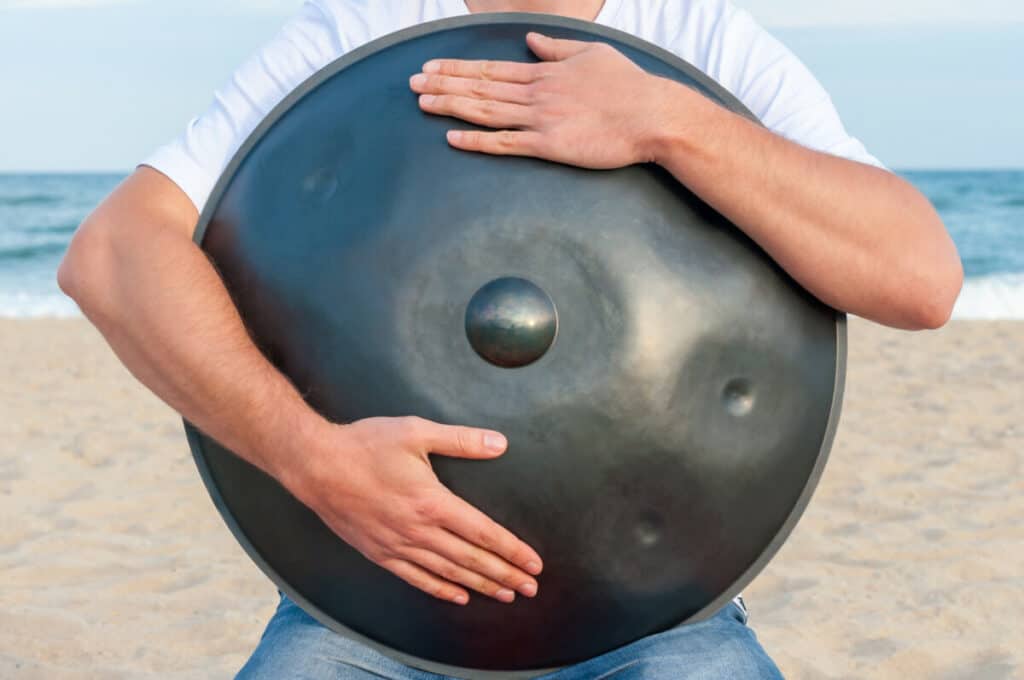
I don’t own a handpan, but a busker let me play his handpan for a couple of minutes, and I learned this: You can sound amazing even if you have basic percussion skills. All things considered, it’s a very accessible instrument (except maybe the price).
The handpan is played by striking the concave or convex divots along the surface of the metal. It kind of sounds like steel drums you might hear in calypso music except … just amazing.
Reasons Why a Handpan Is Easy
- Tuned to a scale: Often these handpans are tuned to a scale with notes that sound amazing, together. You can’t play a wrong note, basically. Since these instruments are expensive and tuned to a particular scale, it’s often played solo or with a percussion instrument
- Intuitive: Although there are many complex techniques to unlock the true potential of the handpan, you simply strike the divots with your hands. It feels very natural to play.
- Percussion and melody all in one go: You can make a full song with the handpan all by itself. This video is a great example of that.
Easy Analysis
| Category | Why This Score? | Score (1/5) |
|---|---|---|
| Making Sound | Although making sound on the handpan is simple, there is a trick to pulling away just right so that the handpan resonates, properly. | 4 |
| Basic Techniques | There are many advanced and intermediate techniques, but just to get started, you simply have to learn to flick the divots in such a way that they resonate. When I played one it felt very much like I was playing bongos or some other type of hand drum. (Don’t call a handpan a drum or you may get a snarky comment) | 4 |
| Play a Song | Since the handpan is tuned to a specific scale, you might not be able to play your favorite tunes on it. But, rest assured, whatever you play will sound like a song if you make a few patterns and alternate between them. This can take some practice. | 3 |
| Read Tabs | As far as I know there is no established tab style for handpans. There are so many different handpans tuned to specific scales it would be difficult to do so | NA |
| Intermediate Competency | I’m not sure how hard it is to sound amazing on the handpan, but I am guessing it takes a lot of practice. Someday when I get one I’ll come back here and let you know. I’m guessing a 3 for now. | 3 |
Final Score (Higher is Better)

